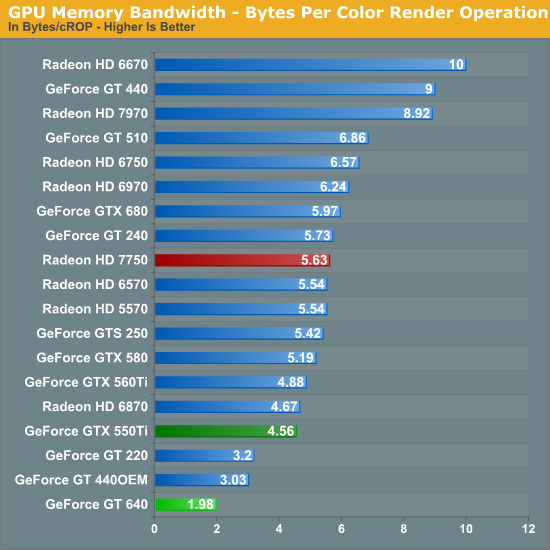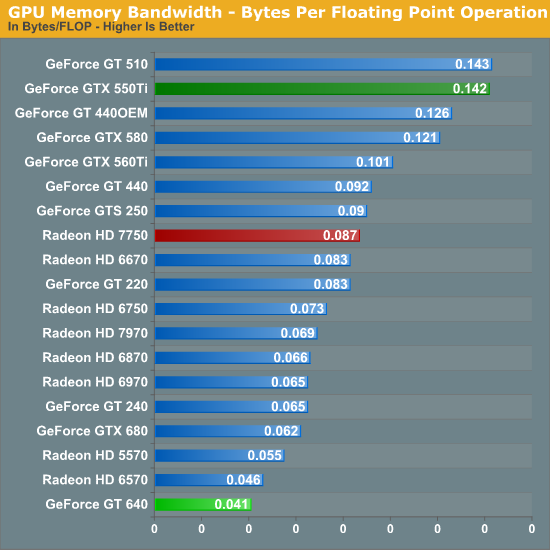Zotac GeForce GT 640 DDR3 Review: Glacial Gaming & Heavenly HTPC
by Ryan Smith & Ganesh T S on June 20, 2012 12:00 PM ESTMusing About Memory Bandwidth & The Test
As we discussed in our introduction, NVIDIA is launching the GeForce GT 640 exclusively as a DDR3 part. Because of the lack of memory bandwidth this is going to hold back the performance of the card, and while we don’t have a GDDR5 card at this time it will still be pretty easy to see what the performance impact is once we jump into our gaming performance section and compare it to other cards like the GTS 450.
In the meantime however we wanted to try to better visualize just how little memory bandwidth the DDR3 GT 640 had. It’s one thing to say that the card has 28GB/sec of memory bandwidth, but how does that compare to other cards? For the answer to that we drew up a couple of graphs based on the ratio of theoretical memory bandwidth to theoretical performance.

The first graph is the ratio of memory bandwidth to color pixel ROPs (bytes per color operation), which is an entirely synthetic metric but a great illustration of the importance of memory bandwidth. Render operations are the biggest consumer of memory bandwidth so this is where DDR3 cards typically choke.
Because of the nature of this graph cards are all over the place, with cards with particularly unusual configurations (such as the 4 ROP GT 440) appearing near the top. Still, high-end cards such as the GTX 680 and Radeon HD 7970 have among the highest ratio of memory bandwidth to color render operations, while lower-end cards generally have a lower ratio. At 1.97 B/cOP, the DDR3 GT 640 has the lowest ratio by far, and is only 66% of the ratio found on the next-lowest card, the GeForce GT 440 OEM. The fact of the matter is that because of its high clockspeed and 16 ROPs, the DDR3 GT 640 has by far the lowest ratio than any other card before it.

Our second graph is the ratio of memory bandwidth to shader operations (bytes per FLOP). Shaders aren’t nearly as bandwidth constrained as ROPs thanks to liberal use of register files and caches, but I wanted to take a look at more than just one ratio. Compared to our ROP chart the GT 640 isn’t nearly as much of an outlier, but it still has the lowest ratio of memory bandwidth per FLOP out of all of the cards in our charts.
Now to be clear not all of this is NVIDIA’s fault. Memory speeds have not kept pace with Moore’s Law, so GPU performance has been growing faster than memory speeds for quite some time leading to a general downwards trend. But the GT 640 is a special card in this respect in that there has never been a card this starved for memory bandwidth. This is further impacted by the fact that while GDDR5 speeds have at least been increasing as a modest rate over the years as GPU memory controllers and memory chip production have improved, DDR3 memory speeds have been locked in the 1.6GHz-1.8GHz range for years. Simply put, the gap between GDDR5 and DDR3 has never been greater. Even a conservative memory clock of 4.5GHz would give a GDDR5 card 2.5 times the memory bandwidth of a typical DDR3 card.
Of course there’s still a place in the world for DDR3 cards, particularly in very low power situations, but that place is shrinking in size every day. If and when it arrives, we expect that the GDDR5 GT 640 will quickly trounce the DDR3 version in virtually all gaming scenarios. DDR3 for a card this power hungry (relatively speaking) and with this many ROPs just doesn’t look like it makes a lot of sense.
The Test
For our test we’re using the latest NVIDIA drivers at the time our benchmarks were taken (301.42), and for AMD’s cards we’re using the new Catalyst 12.6 betas. For analysis purposes we’ve thrown in a couple of additional cards that we don’t normally test, such as the GDDR5 GeForce GT 240. The GDDR5 GT 240 has 43.5GB/sec of memory bandwidth but with a far older and less powerful GPU, which makes for an interesting comparison on progress.
| CPU: | Intel Core i7-3960X @ 4.3GHz |
| Motherboard: | EVGA X79 SLI |
| Chipset Drivers: | Intel 9.2.3.1022 |
| Power Supply: | Antec True Power Quattro 1200 |
| Hard Disk: | Samsung 470 (256GB) |
| Memory: | G.Skill Ripjaws DDR3-1867 4 x 4GB (8-10-9-26) |
| Case: | Thermaltake Spedo Advance |
| Video Cards: |
AMD Radeon HD 7770 AMD Radeon HD 7750-800 AMD Radeon HD 6670 AMD Radeon HD 5750 NVIDIA GeForce GT 640 DDR3 NVIDIA GeForce GTX 550 Ti NVIDIA GeForce GTS 450 NVIDIA GeForce GT 440 NVIDIA GeForce GT 240 |
| Video Drivers: |
NVIDIA ForceWare 301.42 AMD Catalyst 12.6 Beta |
| OS: | Windows 7 Ultimate 64-bit |










60 Comments
View All Comments
MrSpadge - Thursday, June 21, 2012 - link
And they support newer features and cost significantly less to run. Still, the price is ridiculous, especially for DDR3.Taft12 - Wednesday, June 20, 2012 - link
"Zotac has worked themselves into an interesting position as the only partner currently offering a single-slot card"I think EVGA's launched even before Zotac. No blocked mini-HDMI port either!
http://www.newegg.ca/Product/Product.aspx?Item=N82...
nathanddrews - Wednesday, June 20, 2012 - link
First off, I want to thank you for testing the 4K capabilities of this card. While disappointing that there is no DP output for 4K@60Hz, I suppose it's only a matter of time.Second, and more important, I wanted to make you aware of this in case you haven't seen it. Shot in 4K, edited in 4K, mastered in 4K and you can buy it in any format including Blu-ray (1080p), 2560x1440p, and even its raw 140GB 4K Cineform resolution. Seeing as how one of you awesome people now has the Sony 1000ES (jealous!), you definitely shouldn't waste time showing 4K YouTube clips!
http://timescapes.org/products/default.aspx
http://www.youtube.com/watch?v=e-GYrbecb88
Hrel - Wednesday, June 20, 2012 - link
I saw a GTX560 on newegg for 145bucks after MIR today. Whenever people ask me about gaming cards and say they don't want to spend much more than 100 bucks I say, cut back on coffee for a week or skip that night at the bars and just spend the extra 30 bucks or so. Makes absolutely NO sense to handicap yourself over 30 bucks. GTX560 FTW!!!just4U - Thursday, June 21, 2012 - link
That's pretty much where the 7750 comes in. Performance overall is fairly similiar. Plus you can do away with the confusion since the 560 comes in 4-5 different flavors, yes?maroon1 - Saturday, June 23, 2012 - link
What ?! GTX 560 is much faster than even HD7770.http://www.anandtech.com/show/5541/amd-radeon-hd-7...
Lolimaster - Wednesday, June 20, 2012 - link
So slow that a 6670 feels like high end and 7750 a total monster. $109 for these joke of a gpu (gt640)? You must be trolling.Lolimaster - Wednesday, June 20, 2012 - link
A8 5800K is a tiny bit slow thatn 6670 so it should be faster (for free with the APU) than a $109 nvidia discrete gpu.bhima - Wednesday, June 20, 2012 - link
This card is horrible. I was initially unimpressed with AMD's 7750 and 7770 performance, but now those cards just look beastly compared to this. This should be a $50-60 card at max for that kind of performance. Hell I think my 540m performs almost as good as this card.staryoshi - Wednesday, June 20, 2012 - link
GDDR5 would have really lifted the performance of this card. I'm sure they went with GDDR3 as a cost-saving measure and to not canibalize the sale of other cards.. but at this price point it's not a compelling item at all for most.They really need to get the 28nm process under control and wrangle in pricing on this pup.